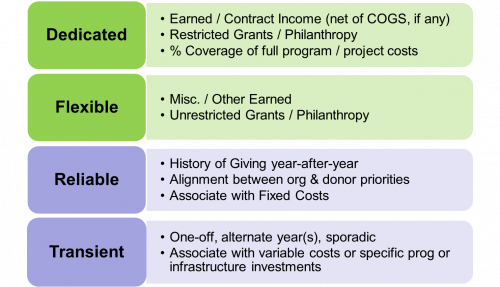About Us
Associate Fixed Costs with Reliable Revenue
If reliable revenue is sufficient to cover fixed costs, an organization then knows it can adjust its variable costs to match its success in reaching its transient revenue goals.
Reliable vs. Transient Revenue
• Reliable revenue can be counted upon from year-to-year. Examples include annual renewing subscribers, interest from highly liquid short-term investments such as Certificates of Deposit, long-standing annual foundation gifts or government grants for general operating, long-standing contracts with government agencies or other entities, and board contributions. During a recession, pandemic, or other economic disruptions, many revenue sources that have traditionally been dependable could become less so, moving from reliable more toward transient.
• Transient revenue can fluctuate with program offerings. Examples include admissions revenue, participation fees, and project-oriented grants.
• Earnings from endowments that is usually considered reliable can be particularly hard hit during a recession or an unstable economy. Building and maintaining accessible operating reserves and special purpose funds is recommended for small and midsized organizations before building permanently restricted endowments.

Fixed vs. Variable Costs
• Fixed costs are usually unavoidable and not ordinarily affected by the number of projects, programs, plays, workshops, or classes given or clients served. Examples of fixed costs include permanent full-time staff, office rent, principal & interest payments on long-term loans, etc.
• Variable costs are usually project-oriented and are more controllable or adjustable. Examples include the # of characters in a play, the # of participants served by a program, the # of weeks a program runs, the # of exhibitions or concerts, # of program-related staff or contractors, local or international professionals, additional space rental requirements, etc.
• Semi-variable costs are in between. These costs must happen but can be mitigated somewhat. Examples include choosing black & white vs. color for a print job, bulk ordering of necessary items, a short-term rental vs. the purchase of equipment, engaging part-time temporary help rather than hiring full-time permanent staff, etc.




